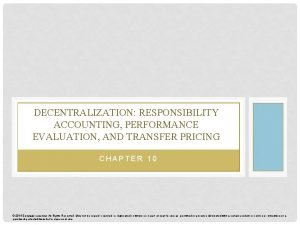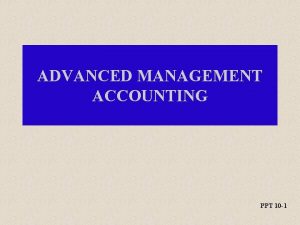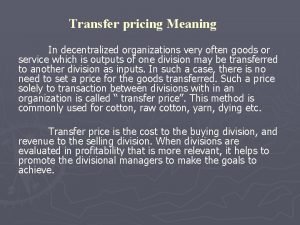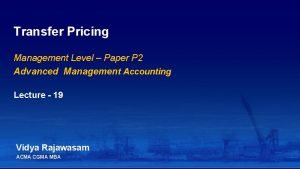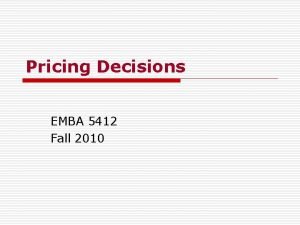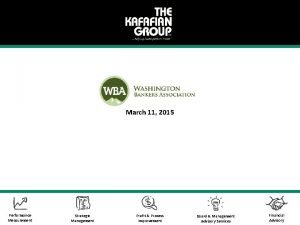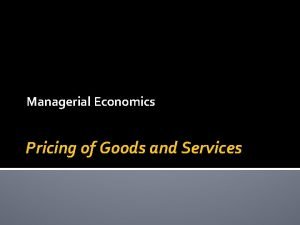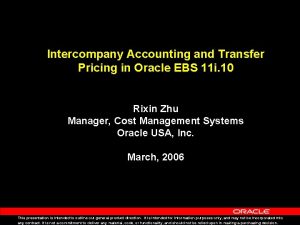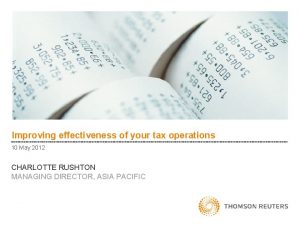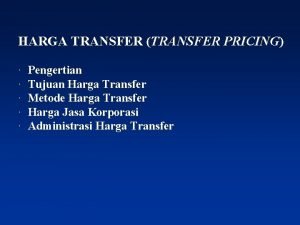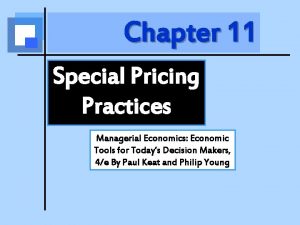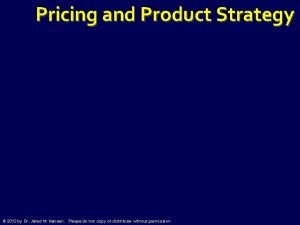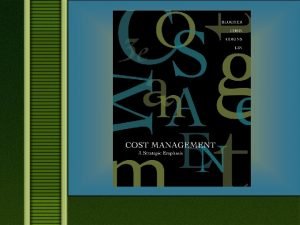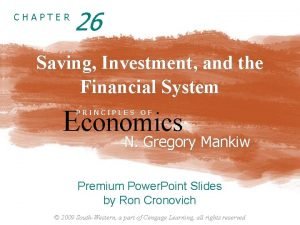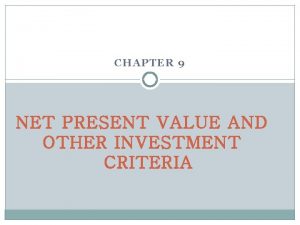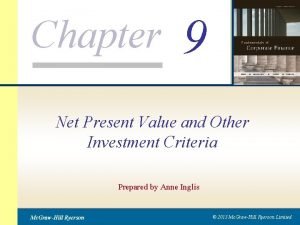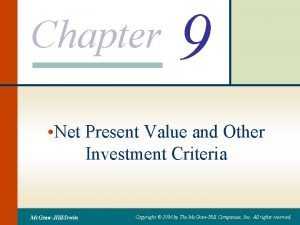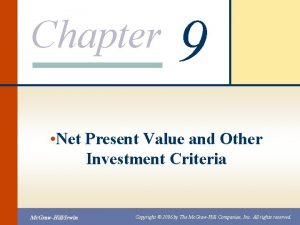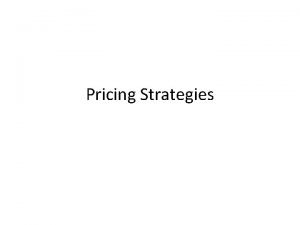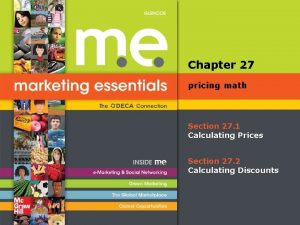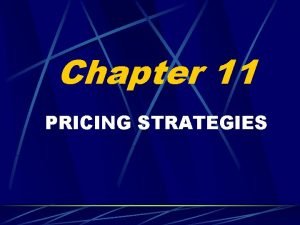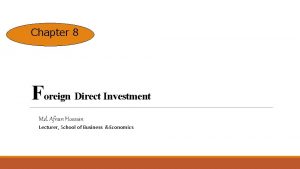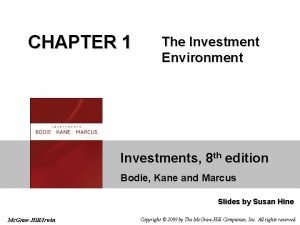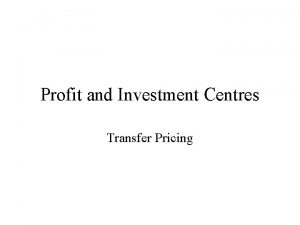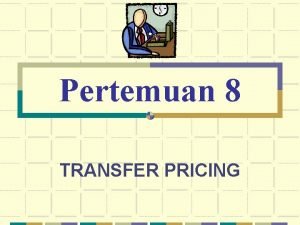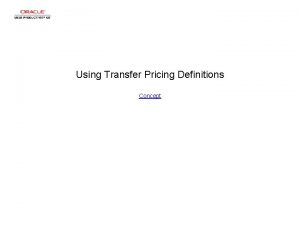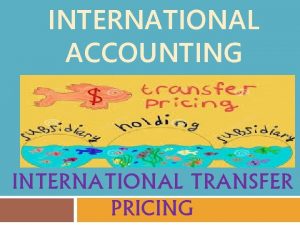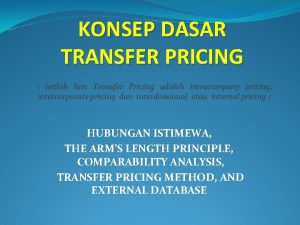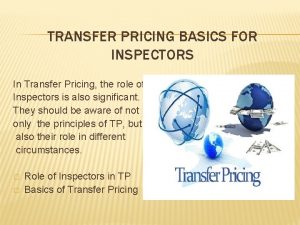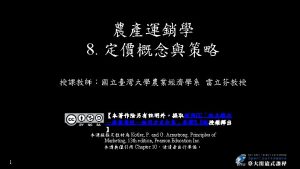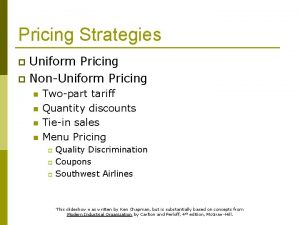Chapter 18 Strategic Investment Units and Transfer Pricing

















































- Slides: 49


Chapter 18 Strategic Investment Units and Transfer Pricing

3 Learning Objectives n Identify the objectives of strategic investment units n Explain the use of return on investment (ROI) and identify its advantages and limitations n Explain the use of residual income and identify its advantages and limitations Mc. Graw-Hill/Irwin © 2005 The Mc. Graw-Hill Companies, Inc. , All Rights Reserved.

4 Learning Objectives n Explain the use of economic value added (EVA) in evaluating strategic investment units n Explain the objectives of transfer pricing, the different transfer pricing methods, and when each method should be used n Discuss the important international tax issues in transfer pricing Mc. Graw-Hill/Irwin © 2005 The Mc. Graw-Hill Companies, Inc. , All Rights Reserved.

5 Learning Objective One Identify the objectives of strategic investment units Mc. Graw-Hill/Irwin © 2005 The Mc. Graw-Hill Companies, Inc. , All Rights Reserved.

6 The Strategic Role of Investment Units ý To motivate managers to exert a high level of effort to achieve the goals of the firm. ý To provide the right incentive for managers to make decisions that are consistent with the goals of top management. ý To fairly determine the rewards earned by the managers for their effort and skill. Mc. Graw-Hill/Irwin © 2005 The Mc. Graw-Hill Companies, Inc. , All Rights Reserved.

7 Key Terms Return on investment (ROI) is profit divided by investment in the business unit. Return on equity (ROE) is the return determined when investment is measured as shareholders’ equity. Return on sales (ROS) measures the manager’s ability to control expenses and increase revenues in order to improve profitability. Asset turnover measures the manager’s ability to produce increased sales from a given level of investment. Mc. Graw-Hill/Irwin © 2005 The Mc. Graw-Hill Companies, Inc. , All Rights Reserved.

8 Learning Objective Two Explain the use of return on investment (ROI) and identify its advantages and limitations Mc. Graw-Hill/Irwin © 2005 The Mc. Graw-Hill Companies, Inc. , All Rights Reserved.

9 Using Return on Investment For ROI to be useful, income and investment must be determined consistently and fairly. This means. . . • Income and investment must be measured in the same way for each unit. • The measurement method must be reasonable and fair for all units. Mc. Graw-Hill/Irwin © 2005 The Mc. Graw-Hill Companies, Inc. , All Rights Reserved.

10 Asset Measurement For Long-Lived Assets. . . Œ Depreciation policy. The determination of the useful life of the asset and the depreciation method will affect both income and investment. Capitalization policy. The firm’s capitalization policy states when an item is expensed or capitalized. Mc. Graw-Hill/Irwin © 2005 The Mc. Graw-Hill Companies, Inc. , All Rights Reserved.

11 Asset Measurement For Inventory. . . Inventory measurement methods. The choice of inventory cost flow assumption (FIFO, LIFO) will affect income and the measurement of inventory. Absorption costing. The effect of absorption costing is to create an upward bias on net income when inventory increases. Disposition of variances. Standard cost variances may be closed to cost of goods sold or pro-rated to the inventory accounts; the choice will have a direct effect on income and the inventory balances. Mc. Graw-Hill/Irwin © 2005 The Mc. Graw-Hill Companies, Inc. , All Rights Reserved.

12 Return on Investment ROI = Return on sales × Asset Turnover Profit Sales Mc. Graw-Hill/Irwin Sales Assets © 2005 The Mc. Graw-Hill Companies, Inc. , All Rights Reserved.

13 Return on Investment ROI, Return on Sales, and Asset Turnover for Compu. City Midwest Region Mc. Graw-Hill/Irwin © 2005 The Mc. Graw-Hill Companies, Inc. , All Rights Reserved.

14 Return on Investment ROI, Return on Sales, and Asset Turnover for Compu. City Midwest Region $8, 000 ÷ $200, 000 Mc. Graw-Hill/Irwin $200, 000 ÷ $50, 000 © 2005 The Mc. Graw-Hill Companies, Inc. , All Rights Reserved.

15 Return on Investment ROI, Return on Sales, and Asset Turnover for Compu. City Midwest Region $26, 200 ÷ $430, 000 Mc. Graw-Hill/Irwin $8, 000 ÷ $50, 000 © 2005 The Mc. Graw-Hill Companies, Inc. , All Rights Reserved.

16 Measuring Investment Historical cost is the value of current assets plus the net book value of the long-lived assets. Net book value is the historical cost of the asset less accumulated depreciation. Gross book value is historical costs without the reduction for depreciation. Replacement cost represents the current cost to replace the assets at the current level of service of functionality. Mc. Graw-Hill/Irwin Liquidation value is the price that could be received for the sale of the assets. © 2005 The Mc. Graw-Hill Companies, Inc. , All Rights Reserved.

17 Interpretation of ROI n Accounting Policies That Affect ROI l l Revenue and expense recognition. Inventory and long-lived asset measurement Inventory cost flow assumptions, absorption costing, disposition of standard cost variances. n Long-lived asset depreciation policy and policy concerning capitalization. n Mc. Graw-Hill/Irwin © 2005 The Mc. Graw-Hill Companies, Inc. , All Rights Reserved.

18 Interpretation of ROI n Other Effect on Income l l Mc. Graw-Hill/Irwin Nonrecurring items. Income taxes. Foreign exchange gains and losses. Joint cost sharing. © 2005 The Mc. Graw-Hill Companies, Inc. , All Rights Reserved.

19 Interpretation of ROI n Other Effects on Investment l l l Mc. Graw-Hill/Irwin Determining which assets are included. Joint cost sharing. Current cost. © 2005 The Mc. Graw-Hill Companies, Inc. , All Rights Reserved.

20 Interpretation of ROI $26, 000 ÷ $195, 500 = 13. 30% Mc. Graw-Hill/Irwin © 2005 The Mc. Graw-Hill Companies, Inc. , All Rights Reserved.

21 Return on Investment Advantages Limitations > Easily understood > Comparable to interest rates and the rates of return on alternative investments > Widely used > Disincentive for high ROI units to invest in projects with ROI greater than the minimum rate of return but less than the unit’s current ROI. Mc. Graw-Hill/Irwin © 2005 The Mc. Graw-Hill Companies, Inc. , All Rights Reserved.

22 Learning Objective Three Explain the use of residual income and identify its advantages and limitations Mc. Graw-Hill/Irwin © 2005 The Mc. Graw-Hill Companies, Inc. , All Rights Reserved.

23 Residual Income Residual income is a dollar amount equal to the income of the business unit less a charge for the investment in the unit. The charge is determine by taking the firm’s desired minimum rate of return times the amount of the investment. Mc. Graw-Hill/Irwin © 2005 The Mc. Graw-Hill Companies, Inc. , All Rights Reserved.

24 Residual Income Mc. Graw-Hill/Irwin © 2005 The Mc. Graw-Hill Companies, Inc. , All Rights Reserved.

25 Residual Income Advantages > Supports incentive to accept all projects with ROI greater than then minimum rate of return > Can use the minimum rate of return to adjust for differences in risk > Can use a different minimum rate of return for different types of assets. Mc. Graw-Hill/Irwin Limitations > Favors large units when the minimum rate of return is low > Not as intuitive as ROI > May be difficult to obtain a minimum rate of return © 2005 The Mc. Graw-Hill Companies, Inc. , All Rights Reserved.

26 Both ROI and Residual Income Advantages > Congruent with top management goals for return on assets > Comprehensive financial measure; includes all the elements important to top management: revenues, costs, and investments > Comparability; expands top management’s span of control by allowing comparison across business units. Mc. Graw-Hill/Irwin © 2005 The Mc. Graw-Hill Companies, Inc. , All Rights Reserved.

27 Both ROI and Residual Income Limitations > May mislead strategic decision making; not as comprehensive as the balanced scorecard which includes customer satisfaction, internal processes, and learning as well as financial measures; the balanced scorecard is linked directly to strategy. > Measurement issue; variations in the measurement of inventory and long-lived assets; also, variations in the treatment of non-recurring items, income taxes, foreign exchange effects, and the use/cost of shared assets. > Short-term focus; investments with long-term benefits may be neglected. Mc. Graw-Hill/Irwin © 2005 The Mc. Graw-Hill Companies, Inc. , All Rights Reserved.

28 Learning Objective Four Explain the use of economic value added (EVA) in evaluating strategic investment units Mc. Graw-Hill/Irwin © 2005 The Mc. Graw-Hill Companies, Inc. , All Rights Reserved.

29 Economic Value Added Economic value added (EVA) is a business unit’s income after taxes and after deducting the cost of capital. In contrast to RI, EVA uses the firm’s cost of capital instead of a minimum rate of return. Mc. Graw-Hill/Irwin © 2005 The Mc. Graw-Hill Companies, Inc. , All Rights Reserved.

30 Learning Objective Five Explain the objectives of transfer pricing, the different transfer pricing methods, and when each method should be used Mc. Graw-Hill/Irwin © 2005 The Mc. Graw-Hill Companies, Inc. , All Rights Reserved.

31 Transfer Pricing The determination of an exchange price when different business units within a firm exchange products or services. Mc. Graw-Hill/Irwin © 2005 The Mc. Graw-Hill Companies, Inc. , All Rights Reserved.

32 Objectives of Transfer Pricing Œ To motivate managers. To provide an incentive for managers to make decisions consistent with the firm’s goals. Ž To provide a basis for fairly rewarding the managers. Mc. Graw-Hill/Irwin These are the same as the SBU objectives! © 2005 The Mc. Graw-Hill Companies, Inc. , All Rights Reserved.

33 Transfer Pricing Methods n Variable cost – sets the transfer price equal to the variable cost of the selling unit. n Full cost – sets the transfer price as the variable cost plus allocated fixed cost for the selling unit. n Market price – Set the transfer price as the current price for the selling unit’s product in the market. n Negotiated price – involves a negotiation process and sometimes arbitration between units to determine the transfer price. Mc. Graw-Hill/Irwin © 2005 The Mc. Graw-Hill Companies, Inc. , All Rights Reserved.

34 Variable Cost Method Advantage Limitation Causes buyer to act as desired, to buy inside. Unfair to seller if seller is profit or investment SBU. Mc. Graw-Hill/Irwin © 2005 The Mc. Graw-Hill Companies, Inc. , All Rights Reserved.

35 Full Cost Method Advantage > Easy to implement > Intuitive and easily understood. > Preferred by tax authorities over variable cost. Mc. Graw-Hill/Irwin Limitation > Irrelevance of fixed cost in decision making; fixed costs should be ignored in the buyer’s choice of whether to buy inside or outside the firm. > If used, should be standard rather than actual cost. © 2005 The Mc. Graw-Hill Companies, Inc. , All Rights Reserved.

36 Market Price Method Advantage Limitation § Helps to preserve unit autonomy. § Provide for the selling unit to be competitive with outside suppliers. § Has arm’s-length standard desired by taxing authorities. § Often intermediate products have no market price. § Should be adjusted for cost savings such as reduced selling costs, no commissions, etc. Mc. Graw-Hill/Irwin © 2005 The Mc. Graw-Hill Companies, Inc. , All Rights Reserved.

37 Negotiated Price Method Advantage § May be most practical approach when there is significant conflict. Mc. Graw-Hill/Irwin Limitation § Need negotiation rule and/or arbitrations procedure, and this may reduce autonomy. § Potential tax problems; may not be considered arm’s length. © 2005 The Mc. Graw-Hill Companies, Inc. , All Rights Reserved.

38 Choosing the Right Transfer Price If there is no outside supply. . . Decision to Transfer: Buy inside. Transfer Price: Cost or negotiated price. Mc. Graw-Hill/Irwin © 2005 The Mc. Graw-Hill Companies, Inc. , All Rights Reserved.

39 Choosing the Right Transfer Price If there is an outside supply. . . Is the seller’s variable costs < outside price? No. Decision to Transfer: Buy outside. Transfer Price: No transfer price. Mc. Graw-Hill/Irwin © 2005 The Mc. Graw-Hill Companies, Inc. , All Rights Reserved.

40 Choosing the Right Transfer Price If there is an outside supply. . . Is the seller’s variable costs < outside price? Yes. Does seller have excess capacity? Yes. Decision to Transfer: Buy inside. Transfer Price: Low – variable cost, High – market price. Mc. Graw-Hill/Irwin © 2005 The Mc. Graw-Hill Companies, Inc. , All Rights Reserved.

41 Choosing the Right Transfer Price If there is an outside supply. . . Is the seller’s variable costs < outside price? Yes. Does seller have excess capacity? No. If contribution from outside purchase > contribution from inside purchase. . . Decision to Transfer: Buy outside. Transfer Price: No transfer price. Mc. Graw-Hill/Irwin © 2005 The Mc. Graw-Hill Companies, Inc. , All Rights Reserved.

42 Choosing the Right Transfer Price If there is an outside supply. . . Is the seller’s variable costs < outside price? Yes. Does seller have excess capacity? No. If contribution from outside purchase < contribution from inside purchase. . . Decision to Transfer: Buy inside. Transfer Price: Market price. Mc. Graw-Hill/Irwin © 2005 The Mc. Graw-Hill Companies, Inc. , All Rights Reserved.

43 Transfer Pricing Example The High Value Computer Company Key assumptions: l Manufacturing unit can buy the x-chip inside or outside. l X-chip can sell inside or outside. l X-chip unit is at full capacity (150, 000 units). l One x-chip is needed for each computer manufactured. Other Information: l Unit selling price of computer $850. l Variable manufacturing costs(excluding x-chip) $650. l Variable unit manufacturing cost of x-chip $60. l Price of x-chip sold to outside supplier $95. l Outside supplier price of x-chip $85. Mc. Graw-Hill/Irwin © 2005 The Mc. Graw-Hill Companies, Inc. , All Rights Reserved.

44 Transfer Pricing Context for High Value Computer INTERNAL FOREIGN Suppliers of Parts and Components Sales Unit Pric INTERNAL TO THE FIRM - DOMESTIC EXTERNAL X-Chip Unit Purchaser of X-Chips Price = $95 e=$ 400 Manu- Price = Transfer Price = ? facturing Unit Price = Seller of $85 Price = $850 X-Chips Sales Unit Mc. Graw-Hill/Irwin © 2005 The Mc. Graw-Hill Companies, Inc. , All Rights Reserved.

45 Transfer Pricing Example Option 1 X-Chip Unit Sells to Outside Supplier Mc. Graw-Hill/Irwin © 2005 The Mc. Graw-Hill Companies, Inc. , All Rights Reserved.

46 Transfer Pricing Example Option 2 X-Chip Unit Sells Inside The firm benefits more from Option 1. Mc. Graw-Hill/Irwin © 2005 The Mc. Graw-Hill Companies, Inc. , All Rights Reserved.

47 Learning Objective Six Discuss the important international tax issues in transfer pricing Mc. Graw-Hill/Irwin © 2005 The Mc. Graw-Hill Companies, Inc. , All Rights Reserved.

48 International Tax Issues in Transfer Pricing The arm’s length standard calls for setting transfer prices to reflect the price that unrelated parties acting independently would have set. There are three widely used methods: 1. The comparable price method 2. The resale price method 3. The cost-plus method Mc. Graw-Hill/Irwin © 2005 The Mc. Graw-Hill Companies, Inc. , All Rights Reserved.

49 End of Chapter Eighteen Mc. Graw-Hill/Irwin © 2005 The Mc. Graw-Hill Companies, Inc. , All Rights Reserved.
 Fixed investment and inventory investment
Fixed investment and inventory investment Responsibility accounting and transfer pricing
Responsibility accounting and transfer pricing Role of management accounting ppt
Role of management accounting ppt Role of transfer pricing in a decentralized company
Role of transfer pricing in a decentralized company Transfer pricing example
Transfer pricing example Transfer pricing examples
Transfer pricing examples Transfer pricing example
Transfer pricing example Importance of transfer pricing
Importance of transfer pricing Fund transfer pricing
Fund transfer pricing Transfer pricing in managerial economics
Transfer pricing in managerial economics Multi-state transfer pricing analysis
Multi-state transfer pricing analysis Oracle transfer pricing
Oracle transfer pricing Oecd business restructuring
Oecd business restructuring Transfer pricing
Transfer pricing Global transfer pricing survey
Global transfer pricing survey Wu transfer pricing center
Wu transfer pricing center Pengertian transfer pricing
Pengertian transfer pricing Transfer pricing in managerial economics
Transfer pricing in managerial economics The strategic pricing pyramid
The strategic pricing pyramid Botox dilution table
Botox dilution table When units manufactured exceed units sold:
When units manufactured exceed units sold: Strategic hospitality technology investment
Strategic hospitality technology investment What is strategic investment unit
What is strategic investment unit Strategic investment framework
Strategic investment framework Strategic substitutes and complements
Strategic substitutes and complements Io model strategic management
Io model strategic management Cultural aspects of strategy choice
Cultural aspects of strategy choice Mass transfer coefficient units
Mass transfer coefficient units Fuller et al equation
Fuller et al equation Repeating disturbance that transfers energy
Repeating disturbance that transfers energy Strategic fit vs strategic intent
Strategic fit vs strategic intent Chapter 6 theories of international trade and investment
Chapter 6 theories of international trade and investment Mankiw chapter 26 solutions
Mankiw chapter 26 solutions Chapter 9 net present value and other investment criteria
Chapter 9 net present value and other investment criteria Net present value and other investment criteria
Net present value and other investment criteria Npv profiles
Npv profiles Chapter 9 net present value and other investment criteria
Chapter 9 net present value and other investment criteria Chapter 26 pricing strategies answer key
Chapter 26 pricing strategies answer key Chapter 27 pricing math
Chapter 27 pricing math Segmented pricing
Segmented pricing Chapter 26 pricing strategies
Chapter 26 pricing strategies Chapter 1 the investment environment
Chapter 1 the investment environment Intermediate accounting chapter 17
Intermediate accounting chapter 17 Cca tax shield formula
Cca tax shield formula Afnan hossain
Afnan hossain Chapter 10 making capital investment decisions
Chapter 10 making capital investment decisions Chapter 1 the investment environment
Chapter 1 the investment environment Chapter 11 admission transfer and discharge
Chapter 11 admission transfer and discharge Chapter 7 heat transfer and change of phase
Chapter 7 heat transfer and change of phase Admission transfer and discharge
Admission transfer and discharge

